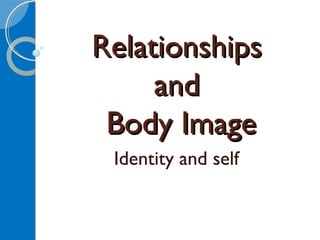
Identity and self
- 2. Consider these two points of view –Consider these two points of view – which approach do you find yourself inwhich approach do you find yourself in most agreement with?most agreement with? “I am who I am because of the time and place I was born and the culture I was raised in. My family gave me a set of values and so has my town, my religion, my community and my country. Add these all up and that’s who I am” “I have got an identity – at least my friends seem to think so, but I’m not really sure who I am. I know that I’m more like some people than others, but this changes as I try out new identities. I don’t really want to take on an identity if it means I can’t be different when I want to be”
- 3. First ApproachFirst Approach “I am who I am because of the time and place I was born and the culture I was raised in. My family gave me a set of values and so has my town, my religion, my community and my country. Add these all up and that’s who I am” This view sees identity as a product of culture – we are fashioned by social and cultural forces together with a sort of genetic blueprint which moulds us into the individuals we are.
- 4. Second ApproachSecond Approach “I have got an identity – at least my friends seem to think so, but I’m not really sure who I am. I know that I’m more like some people than others, but this changes as I try out new identities. I don’t really want to take on an identity if it means I can’t be different when I want to be” This view has a different take on the relationship between culture and the individual. Here, culture provides a set of resources which we are free to use in the construction of our own identity. Rather than being fixed into place by powerful forces, identity is more like a butterfly.
- 5. The DebateThe Debate Neither is right or wrong They represent two sides of a debate over the nature of identity
- 6. Components of IdentityComponents of Identity Career Political views Religious beliefs Relationships Ethnic identity Personality Body image
- 7. SELFSELF All the Characteristics of the Person Self-concept: everything the person believes to be true about him/herself Includes traits, preferences, social roles, values, beliefs, interests, self-categorization Self-understanding develops throughout the lifespan
- 8. Self-Awareness in InfancySelf-Awareness in Infancy Dot-of-rouge experiment Recognize selves in mirror at 15-18 months 15-23 months ◦ Personal pronoun use ◦ Picture recognition ◦ Self-referencing, ownership, self-monitoring
- 9. Self in Early ChildhoodSelf in Early Childhood Confusion of self, mind, and body Concrete descriptions Physical descriptions Activities – what they do Overestimation of abilities
- 10. Self – Middle & Late ChildhoodSelf – Middle & Late Childhood Shift to internal traits and abilities Social role descriptions Real and ideal selves More realistic about abilities
- 11. Perspective TakingPerspective Taking Opposite of egocentrism – the ability to assume another’s perspective Children who are good at this are popular Development progresses through stages (Selman)
- 12. Self in AdolescenceSelf in Adolescence Abstract-idealistic Self-conscious/ preoccupied Contradictions within self Fluctuating picture across time/situations Possible selves Self-integrations as they get older
- 13. Self in AdulthoodSelf in Adulthood Self-awareness (emotional intelligence) ◦ Accept own good and bad qualities Possible selves become more realistic Life review – evaluation of successes & failures; more likely as you get older
- 14. Self-ConceptSelf-Concept This is the idea we have of ourselves as individuals Consists of 3 elements - SELF IMAGE - IDEAL SELF - SELF-ESTEEM
- 15. The Ideal SelfThe Ideal Self An easier concept in theory that is in in practice Trying to probe the Ideal Self in any kind of public context results in gatekeeping: we filter out information that could cause negative perceptions Usually get role models and the ideal self confused